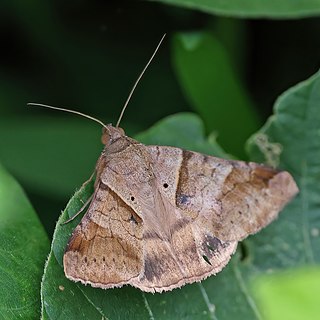
Mocis undata, the brown-striped semilooper, is a moth of the family Erebidae. The species was first described by Johan Christian Fabricius in 1775. It is found in the Afrotropical and Oriental regions, including India and Sri Lanka.
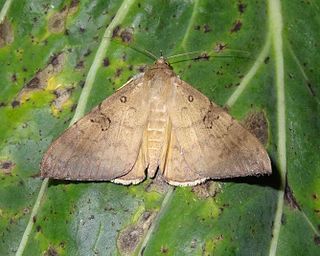
Oxyodes scrobiculata, the longan semi-looper or longan leaf-eating looper, is a moth of the family Erebidae. The common name "looper" is used despite looper moths generally being in the family Geometridae. The species was first described by Johan Christian Fabricius in 1775. It is found in the Indo-Australian tropics of India, Sri Lanka, Myanmar, China, east to Guam, Queensland, New Caledonia, Fiji, Samoa and Tonga.
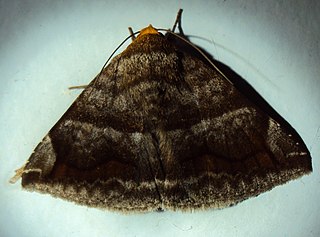
Buzara onelia is a moth of the family Erebidae. It is found from the Indian subregion to Sri Lanka, Myanmar, Sundaland, the Philippines and Japan.

Buzara umbrosa is a moth of the family Erebidae. It is found in China, India and Sri Lanka.

Pindara illibata is a moth of the family Noctuidae first described by Johan Christian Fabricius in 1775. It is found in the Oriental region, including Taiwan, China, India, Sri Lanka, Myanmar, Japan and Borneo.

Trigonodes hyppasia, the triangles or semi-looper, is a moth in the family Erebidae. The species was first described by Pieter Cramer in 1779. It is largely cosmopolitan, found throughout Borneo, Fiji, India, Maldives, Nepal, Sri Lanka, São Tomé and Príncipe, Taiwan, Thailand, Zimbabwe, northern Australia, and almost all African countries.

Chiasmia emersaria is a moth of the family Geometridae. The species was first described by Francis Walker in 1861. It is found in India, Nepal, northern Thailand, China, Sri Lanka, Japan and the Ryukyu Islands.

Apona caschmirensis is a moth of the family Eupterotidae first described by Vincenz Kollar in 1844. It is found in Nepal, Pakistan and India.

Sympis rufibasis is a moth of the family Noctuidae first described by Achille Guenée in 1852. It is found from the Indo-Australian tropics of India, Sri Lanka, Borneo east to New Guinea, the Solomons and Queensland.

Semiothisa eleonora is a moth of the family Geometridae. It is found in south-west Asia, including India, Sri Lanka and Taiwan.

Mnesiloba dentifascia is a moth of the family Geometridae first described by George Hampson in 1891. It is known from the Oriental tropics.
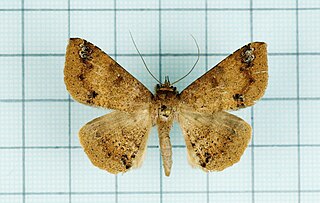
Ericeia inangulata, the sober tabby, is a moth in the family Erebidae. The species was first described by Achille Guenée in 1852. It is found in the Indo-Australian tropics of China, India, Sri Lanka, Myanmar, and the Marianas and Carolines, Fiji, Vanuatu, New Caledonia and Samoa.

Hypena iconicalis is a moth in the family Noctuidae first described by Francis Walker in 1859. It is found in India, Sri Lanka, Taiwan, Papua New Guinea and Fiji.

Plusiodonta coelonota, the snake vine moth, is a moth of the family Erebidae. The species was first described by Vincenz Kollar in 1844. It is found from India, Sri Lanka, Myanmar, Andaman Islands, Australia, Papua New Guinea, to South and South-East Asia.
Glaucoclystis polyclealis is a moth in the family Geometridae described by Francis Walker in 1859. It is found in Sri Lanka and on Borneo, Java and Bali.

Harita rectilinea is a moth of the family Noctuidae described by Frederic Moore in 1882. It is found in India, Sri Lanka, Myanmar, Peninsular Malaysia and on Sumatra and Borneo.
Acantholipes trajecta is a species of moth in the family Erebidae first described by Francis Walker in 1865. It is found in South Africa, India, Sri Lanka, and Australia, where it has been recorded from Western Australia, the Northern Territory and Queensland.
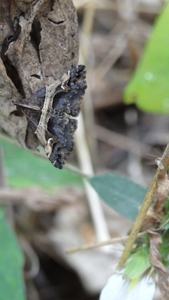
Bertula abjudicalis is a moth of the family Noctuidae first described by Francis Walker in 1859. It is found in India, Thailand, Laos, Vietnam, Taiwan and from Sri Lanka to Australia, where it has been recorded from New South Wales.
Neotogaria galema is a moth in the family Drepanidae first described by Swinhoe in 1894. It is found in Bangladesh.
Wernya solena is a moth in the family Drepanidae. It was described by Swinhoe in 1894. It is found in Assam, India.














